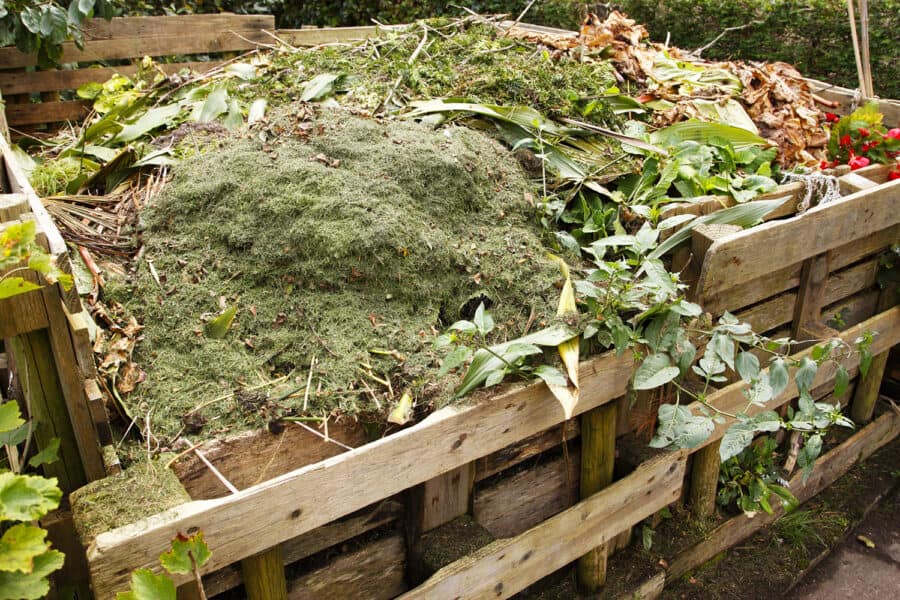Perfecting the art of composting can be tricky, but it’s essential to the health of your garden. Compost adds beneficial microbes to the soil and provides the highest nutrition for your garden plants.
Composting is an essential part of organic gardening. It’s the ultimate recycling of your grass clippings, food waste, and yard waste. It also adds organic matter to your soil which nourishes the soil food web.
What Do You Put In Your Compost Bin?
Many years ago, the standard ingredients for garden compost and fertilizing farm fields were horse manure and straw. This combination created outstanding soil, but offered some challenges in nutrients, depending on the animal’s feed. It also introduced tons of weed seeds. But it was a perfect balance of “browns” and “greens” for composting: high-carbon “brown” materials (straw) and high-nitrogen “green” materials (manure). Both are required in sufficient quantity to create compost.Contrary to popular belief, it’s not worms feeding from the bottom of the pile that creates compost – it’s bacteria and fungi. And just like you and me, microorganisms need food to go about their business. In composting, food is plentiful when your browns and greens have the optimal carbon to nitrogen ratio of 30:1. This ratio helps to “cook” or heat up the pile quickly with bacterial and fungal activity to speed the decay.
Getting the right combination of greens and browns might be a little tricky at first, but with a little experimentation, you’ll get your compost pile cooking. You’ll know when your greens are too high because the pile will smell like garbage. More likely, you’ll have the opposite problem – your pile will cook too slowly. But that’s okay because the ingredients will break down eventually. There’s even a thing called “cold composting” where you just throw everything into a pile in an out-of-the-way place and let it do its thing. Underneath the pile the following year, you’ll find rich compost. Nature takes care of itself.
*Table scraps are excellent for composting as they add valuable bacteria to speed the breakdown. Use anything that’s fruit, grain, or vegetable, but avoid meat scraps, because the smell may attract animals like raccoons, which will tear your bin to shreds trying to get it. Meat scraps may also turn putrid in your bin and create a horrendous odor.
Use a combination of “brown” and “green” ingredients in your compost bin:
- shredded tree leaves
- newspaper (black and white only)
- brown paper bags (shredded)
- non-glossy white paper plates
- plain brown cardboard (non-coated)
- wood ashes
- used tea bags and tea leaves
- paper coffee filters
- table scraps*
- yard waste (tree prunings, weeds, dead plants, etc.)
- grass clippings (no lawn treatments or pesticides)
- vacuum cleaner wastes
- corn stalks and sunflower stalks
- pet or human hair
- coffee grounds
- composted manures
The easiest method of composting
The easiest way to compost is to place shredded autumn leaves in a compost bin along with coffee grounds and give it a stir once a month. Or you can pee on the leaves once in a while (yes, really, because pee is high in nitrogen – just don’t make it your business every day). Let the leaves and coffee grounds sit for a season and voila: compost. Yard waste can be held in bins until it’s time to add them to the compost pile.
Yard waste can be held in bins until it’s time to add them to the compost pile.4 Tips for Speeding Up Your Compost Pile
- Shred or cut everything into small pieces, because the smaller it is the faster it will heat up, and the easier time microbes will have breaking it down. If your browns to greens balance are correct, the pile should create heat on its own within a week or two (steam will actually rise from it) and you should have finished compost in one or two months.
- Build your pile where it gets at least 6 hours of direct sunlight each day. This isn’t critical, but it helps to speed things along.
- Stir your compost pile once a week or less – bacteria need oxygen to speed the breakdown of the compost, but stirring too much can slow the process.
- Make sure the pile stays damp but not soaked. I leave mine out in the open so that the rain takes care of the moisture requirements. If we have a dry spell, I water the compost pile at least once a week.
- When you add fresh ingredients to your new compost, take a handful of soil from your garden and throw it on top – the soil contains microbes that will kick-start the fermenting process. Water it in.
How Do You Know When Compost Is Finished?
When compost is finished, it will look crumbly, be the color of chocolate, and have a pleasant, earthy smell, not foul in any way. The finished pile will also be much smaller than the pile you started with – about two-thirds smaller, depending on your ingredients. Dump it on your garden and start again!This article was first published on bigblogofgardening.com.





